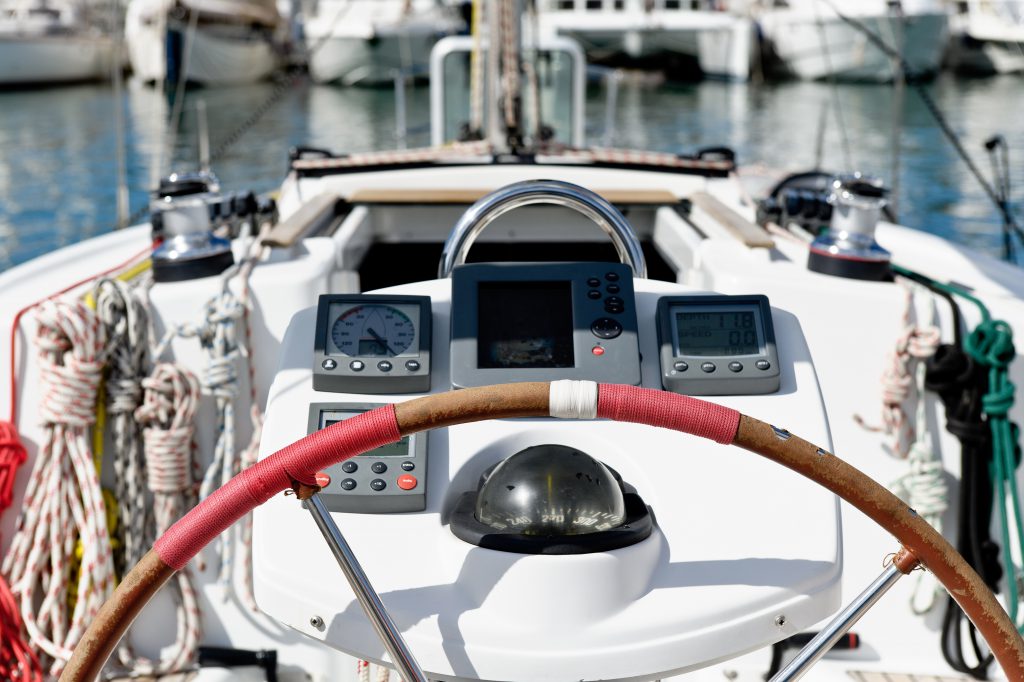More Things to Check When Buying a Used Boat (Part Four)
November 6th, 2020 by team

by B.J. Porter (Contributing Editor)
Read Part I, Part II, and Part III of buying a used boat.
For the last part of what you look at when you are shopping for a used boat, we’re going to get into the electrical and electronic systems. There’s a lot to look for, and like the other things, a few quick spot checks can save you some trouble.
Unfortunately, many brokers won’t know all the ins and outs of operating the electronics on all the boats they show. Even if they turn them on for you, it may not show you how well they’re working. A seller in a private sale should be able to show you everything, otherwise you’re going to rely on your visual checks and what you can get the broker to do.
Electrical Wiring and Batteries
There are several very clear and well-defined standards for how install boat wiring and electrical systems. The American Boat and Yacht Council has a thick book you can check against. The bad news is, many boat builders don’t follow it. And even fewer boat owners know about the standards, so when you look at do-it-yourself electrical projects on older boats you never know quite what you’ll find.
Wiring Standards
Detailed ABYC standards aside, there are a few things you want to keep an eye out for that will hint of problems now or in the future. If you’re lucky, you’ll look behind a fuse panel and find color-coded wiring with clear labels and everything crimped, tucked and sealed. Think about buying a lottery ticket if you see that, because it may be your lucky day – it’s not that common.
Ask to see behind the main panel to look for a few things. Most have a quick release to give access to the backside where you hope to see:
- Color coded wiring. At a minimum, black for ground and red for positive wires.
- Labels – either numbered to a key or labeled with words.
- Crimped connections with heat shrink wrapping. Soldered connections are less preferable, but if covered with heat-shrink tubing, it is acceptable.
- Neat connections with no exposed wire cores.
- Proper fusing. You won’t be able to tell what the right fuse should be, but check for fusing on devices not wired through the main breaker panel.
Red flags on wiring include:
- Wire nuts on any connections. These are never appropriate on a boat.
- Loose connections without crimping or soldering. Electrical tape is for keeping connections dry and sealer, not holding them in place.
- Corrosion, burn marks, scorching, or a burned smell.
- Un-fused wiring. Most electrical panels have breakers, so don’t panic if you don’t see any fuses. But anything which doesn’t go through a circuit on the main board with a breaker needs a proper fuse or breaker.
None of these are deal breakers, but bad wiring needs to be fixed. At best, you’ll have unreliable electrical systems. At worst, improper wiring and short circuits without fusing can lead to a dangerous fire.
The Battery Black Box
Batteries are a pet interest of mine, since they are so essential to comfort and reliability on a boat, and they are so often overlooked. They can be expensive and finicky, and it’s likely they haven’t been replaced recently. So it’s important to ask questions and inspect them if possible. You’ll want to learn:
- The battery chemistry. The main lead-acid types are flooded, AGM, and gel. Lithium (LiFePO4) is becoming more common in cruising and racing boats. Details on the differences between them are outside the scope of this post, but you want to know what you’re buying.
- How old are they? Batteries wear out, but if they aren’t put to heavy use, the seller may not know how bad (or good) they are. Many batteries have a date tag with the month and year of installation, though not every installer thinks to mark them. When I bought my current boat I had to replace eight group 4D Gel batteries within the first year; not a cheap project!
- How many, and how are they arranged? A common arrangement is a dedicated start battery, and one or more dedicated house batteries. There should be an isolation switch between the banks to choose which to work from. House banks wired together should be the same size, brand, and age for best performance.
- How are they charged? Boats with multiple banks may have multiple charge methods, and you want to know what is available. Smaller boats may only have an alternator and maybe a shore power charger, but ask about any solar or wind you see and what the capacity of the chargers are.
- What is the capacity? The banks should be rated in Amp-hours as a measure of capacity. Without knowing the details of installed systems, you can’t know if it’s enough. But you may need more if they have added systems without adding batteries, and it’s good to know.
Look for corrosion and rust, loose connections, and that the batteries are secured well. There’s shouldn’t be any cracks, swelling, or distortion in the battery cases – these are signs the batteries may be aging or have been over charged.
Instruments

Small simple boats may have nothing at all, but larger boats can get into complex systems which are interconnected and trickier to turn on. Hopefully, you can get the showing broker or seller to turn things on for you, just so you can see them work. Even then, it’s no guarantee because some systems which light up still may not work properly, and you won’t find that out until the survey.
But if you can, ask to remove instrument covers to inspect what you see. The savvy seller will have the covers off and the instruments powered up, but there’s no guarantee you’ll get this in a showing or even be able to turn things on.
Inspect for:
- Sun faded or cracked casings on instruments and radios.
- Cracked screens
- Moisture or condensation behind screens and lenses. This can be a sign that the waterproofing on cockpit instrument displays is compromised, which will lead to failure.
- Chafing on any visible wires or connections. You can see this on radio microphones, though most surface mounted electronics do not have exposed wires.
Unless you are buying a nearly new boat, it’s quite likely the instruments on the boat you’re looking at are dated. That’s fine and expected – many older instruments are serviceable, even if they don’t have all the latest whizz-bang features you saw at the boat show. A ten-year-old chart plotter won’t show a movie in the cockpit or have a touch screen, but it will still get you where you are going if it still works.
So look at instruments with an eye for two things – what you might want to replace and what must be replaced. You might find some installed equipment to be serviceable, and what you will need to spend on replacements and upgrades factors into what you want to spend for the boat.
Happy Hunting

Shopping for boats is fun, but it can be a lot of effort to find the right one. Hopefully we’ve equipped you with a few things to look for to help get a solid boat for your money and avoid potential money pits or troublesome purchases.
Only you know what boat is right for you and how you will use it. Your first showings are an introduction to the boat and a basic suitability check. But when you are ready to buy, be sure to engage a professional, credentialed surveyor to make sure all is as it seems.
Good luck!
- Posted in Blog, Boat Care, Boating Tips, Cruising, Fishing, iNavX, Navigation, News, Reviews, Sailing, Sailing Tips
- No Comments
Comments are closed.

